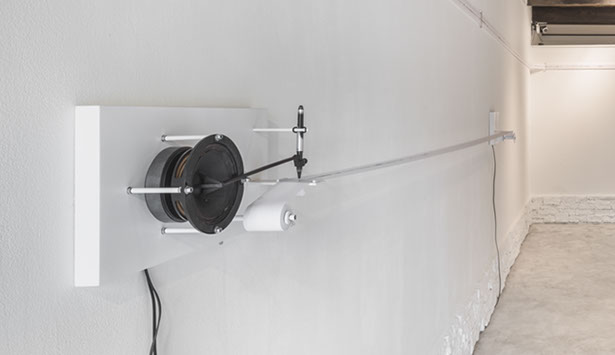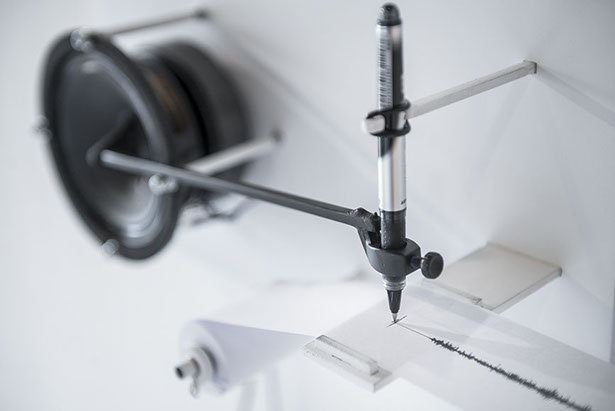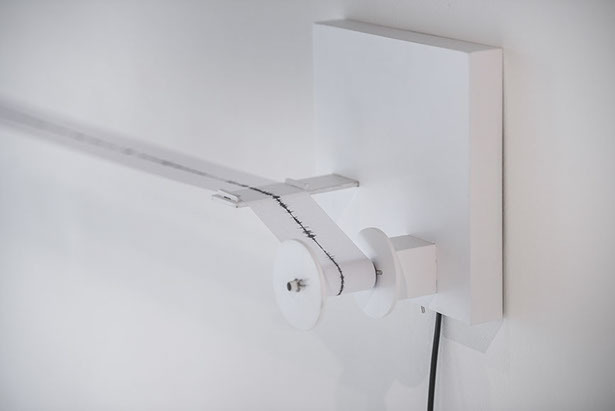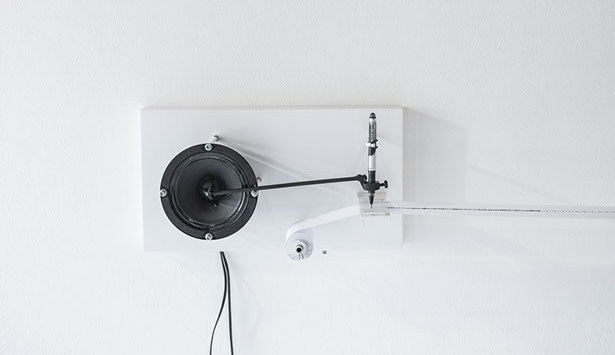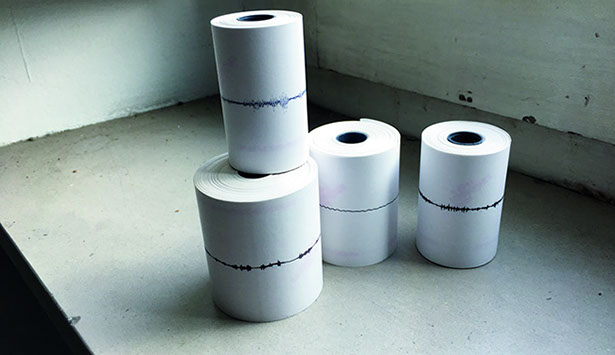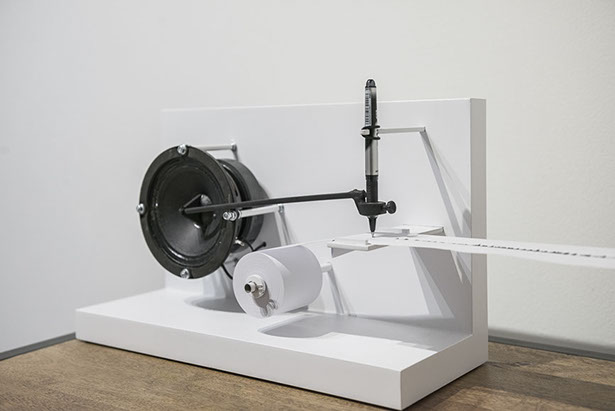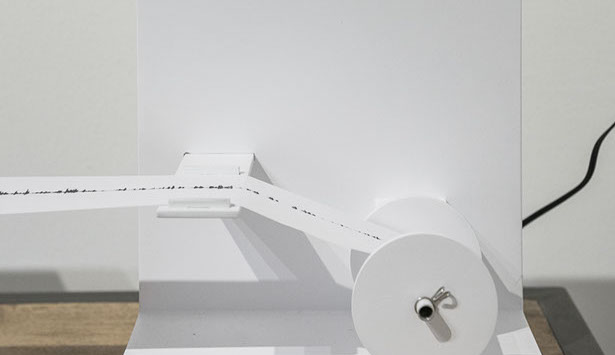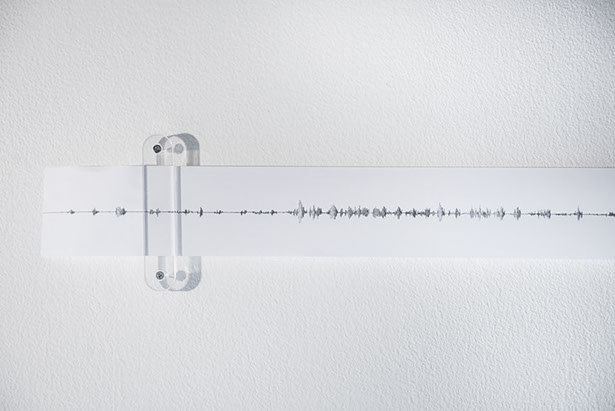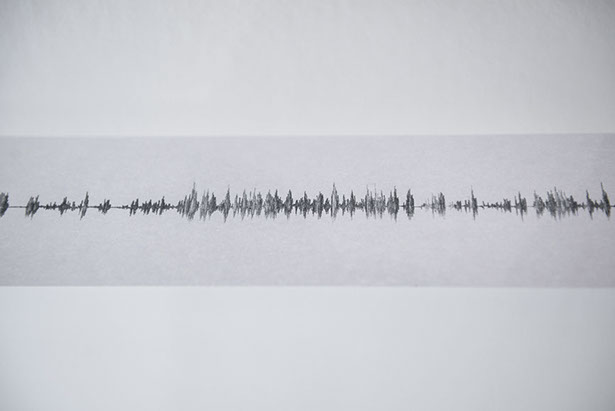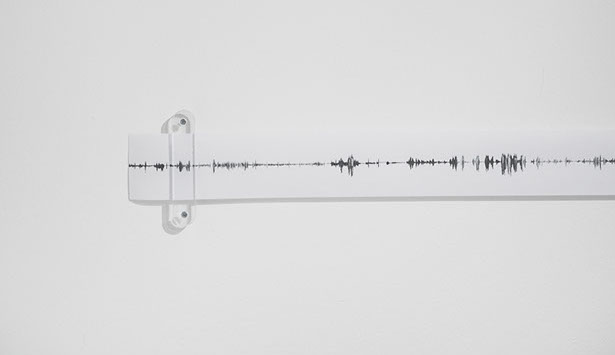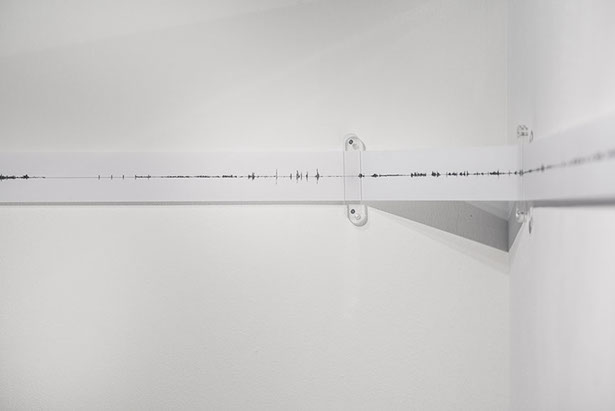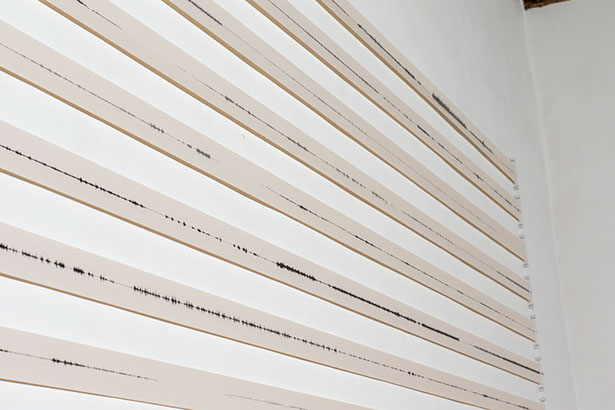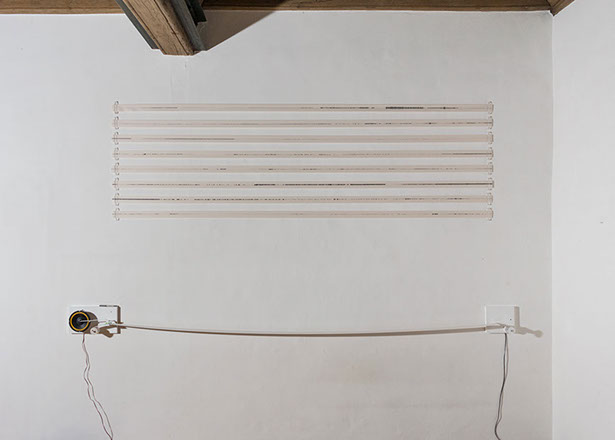MOTI UMANI (Serie da parete, da piano orizzontale e carte) (2021 – in corso)
Marzio Zorio su Moti Umani:
"Come si può dedurre dalle immagini, il suono viene emesso dall’altoparlante, reso udibile, e allo stesso tempo trascritto nella sua forma grafica su dei rotoli di carta di lunghezza 45 metri. Questa trascrizione è esattamente la forma fisica della perturbazione di pressione che il suono provoca attraverso la propagazione nell’aria. Un processo molto simile al principio di funzionamento degli attuali dischi in vinile e prima di allora del fonografo di Edison e del grammofono di Berliner. Ipoteticamente si potrebbe ritradurre in suono la traccia lasciata dall’inchiostro sulla carta.
La similitudine con il sismografo è evidente, ma mentre il primo si concentra sui movimenti terrestri, il mio ”macchinario” si focalizza sul suono prodotto dagli essere umani. Ecco perché attualmente sto sperimentando usando diverse fonti, tutte di origine antropica. Nelle immagini anche un esempio di traccia incisa/trascritta con, tra gli altri, anche il suono delle manifestazioni a Minsk.
Come la scrittura è la forma di trascrizione di un concetto che inizialmente, semplificando, era esposto con il linguaggio parlato nel quale il suono si è perso, questo tipo di grafia ne raccoglie invece anche gli aspetti acustici, come il timbro, il volume e l’intenzione dell’oratore.
Raccogliendo in rotoli il materiale sonoro si crea un ponte tra l’idea di traccia intesa come segno e i primi protolibri dove le pagine non erano ancora separate, ma unite in un unico flusso senza soluzione di continuità."
Testo di Rosanna Musumeci in occasione di un mostra negli spazi dell’ex convento di Noto:
"Il lavoro si inserisce in un ex luogo di culto, oggi luogo della memoria, testimonianza di un passato che continua a raccontarsi nel presente. Vuole farsi sentire, o meglio ascoltare, la storia rappresentata nell’opera: si struttura analogamente all’assetto di un sismografo, per cui anziché rilevare le vibrazioni del terreno, individua le vibrazioni del woofer provocate dall’emissione delle tracce sonore riprodotte. Queste, tramite un sistema di rocchetti che fanno scorrere un nastro di carta, vengono tradotte simultaneamente in forma grafica grazie a un dispositivo di scrittura collegato all’altoparlante, il cui contenuto viene infine raccolto e avvolto in una bobina. Il suono emesso dunque, a seconda della sua intensità, fa vibrare la sorgente, provocando la creazione di moti “sismici” sonori e concreti. A generare questo processo sono fonti acustiche evocate dall’inesauribile risolutezza umana: l’insieme dei fragorosi clamori che avvengono durante contestazioni e proteste, dove le voci che partecipano diventano protagoniste su un terreno comune. Esprimono una reazione, pretendono l’ascolto e arrivano a creare movimenti che determinano il cambiamento: per provocare un terremoto, serve un insieme di scosse. L’intento è evocare quel rumore che si crea solo attraverso un senso comune di ideali e obiettivi, che si estende riverberandosi, anche in modo caotico, dando vita a segnali di disturbo che si pongono, come fine ultimo, il disturbo stesso. Per identificare nell’immediato questo “rumore di massa”, non è strettamente necessario un vocabolario o la conoscenza di una lingua, in quanto l’alfabeto comune e assoluto è caratterizzato proprio da questo frastuono di voci unanimi che nell’opera di Zorio si concretizzano attraverso una riproduzione grafica universale."
MOTI UMANI (Wall-mounted, horizontal top and paper series) (2021 – ongoing)
Marzio Zorio on Moti Umani:
"As can be deduced from the pictures, sound is emitted from the loudspeaker and at the same time transcribed in its graphic form on 45 meters long rolls of paper. This transcription is exactly the physical form of the pressure perturbation that the sound causes through propagation in the air. A process very similar to the working principle of today's vinyl records and before that of Edison's phonograph and Berliner's gramophone. Hypothetically, it is possible to translate the trace left by ink on paper back into sound.
The similarity with the seismograph is obvious, but while the former focuses on earth movements, my "machinery" focuses on the sound produced by human beings. That is why I am currently experimenting using different sources, all of which are anthropomorphic.
In the images is visible an example of an engraved/transcribed track with, among others, the sound of the demonstrations which took place in Minsk.
Just as handwriting is the form of transcription of a concept that was initially expounded with spoken language in which the sound was lost, this type of handwriting instead also collects its acoustic aspects, such as timbre, volume and the speaker's intention.
Collecting the sound material in rolls creates a bridge between the idea of the trace understood as a sign and the early protolibles where the pages were not yet separate, but joined in one seamless flow."
Text by Rosanna Musumeci on the occasion of an exhibition in the spaces of the former convent of Noto:
"The work fits into a former place of worship, now a place of memory, a testimony of a past that continues to tell its story in the present. It wants to be heard, or rather listened to, the story represented in the work: it is structured similarly to the set-up of a seismograph, so instead of detecting the vibrations of the ground, it detects the vibrations of the woofer caused by the emission of the reproduced sound tracks. These, by means of a system of spools running a paper tape, are simultaneously translated into graphic form by a writing device connected to the loudspeaker, the contents of which are finally collected and wound into a coil. The sound emitted therefore, depending on its intensity, causes the source to vibrate, resulting in the creation of sonic and concrete "seismic" motions. Generating this process are acoustic sources evoked by inexhaustible human resolve: the set of thunderous clamors that occur during protests, where participating voices become protagonists on a common ground. They express a reaction, demand to be heard, and come to create movements that bring about change: to cause an earthquake, you need a set of tremors.
The intent is to evoke the noise that is created only through a common sense of ideals and goals, which extends by reverberating, even chaotically, giving rise to signals of disturbance that pose, as the ultimate goal, disturbance itself. To immediately identify this "mass noise," no vocabulary or knowledge of a language is strictly necessary, as the common and absolute alphabet is characterized precisely by this din of unanimous voices, which in Zorio's work is realized through a universal graphic reproduction.
Copyright © 2024 sito di proprietà di Marzio Zorio. All rights reserved.
I contenuti presenti sul sito www.marziozorio.it dei quali è autore il proprietario del sito non possono essere copiati, riprodotti, pubblicati o redistribuiti perché appartenenti all'autore stesso.
È vietata la copia e la riproduzione dei contenuti in qualsiasi modo o forma. È vietata la pubblicazione e la redistribuzione dei contenuti non autorizzata espressamente dall’autore.
